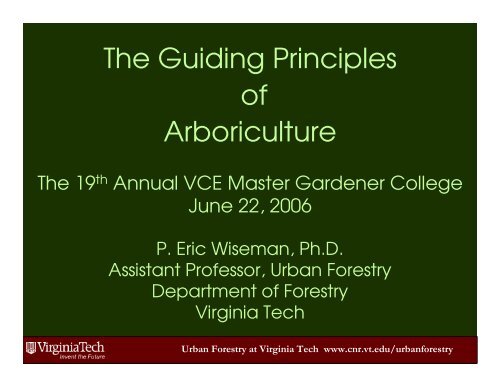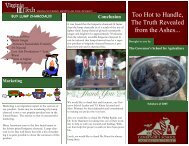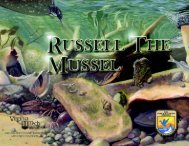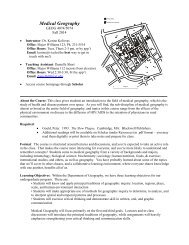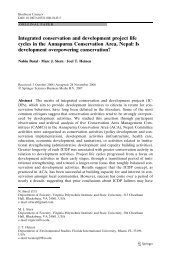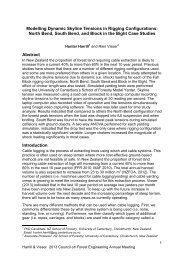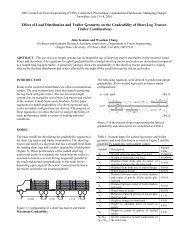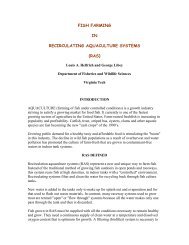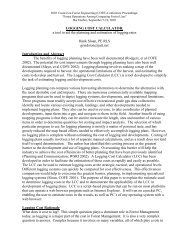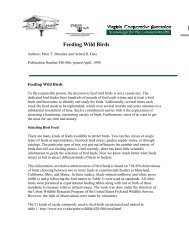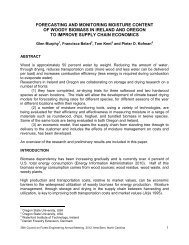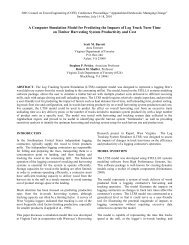The Guiding Principles of Arboriculture - College of Natural ...
The Guiding Principles of Arboriculture - College of Natural ...
The Guiding Principles of Arboriculture - College of Natural ...
You also want an ePaper? Increase the reach of your titles
YUMPU automatically turns print PDFs into web optimized ePapers that Google loves.
What is arboriculture?<strong>The</strong> art, science, and technology <strong>of</strong> selecting, establishing,and maintaining woody plants in and around humansettlements Woody Plants – trees, shrubs, and vines Selection•intended function•site evaluation•species selection•nursery stock evaluation Establishment – site preparation, planting, after-care Maintenance – cultural practices, pest management, pruning
Why arboriculture?<strong>The</strong> urban environment is an inhospitable environment•Disturbed soils•Extreme microclimate•Toxins, pollutants•Pests•Abuse, injury, vandalism
Why arboriculture?<strong>The</strong>re are consequences for “bad trees”•Property damage•Personal injury•Inconvenience•Liability
Why arboriculture?Managed trees are better trees•Functionality•Cost-effectiveness•Longevity•Health•Appearance•Safety
<strong>The</strong> <strong>Guiding</strong> <strong>Principles</strong> <strong>of</strong> <strong>Arboriculture</strong><strong>The</strong> most comprehensive, up-todatearboriculture textbookavailableNow in fourth editionRichard Harris, Pr<strong>of</strong>essor EmeritusEnvironmental HorticultureU. California-DavisISBN: 0130888826
<strong>The</strong> <strong>Guiding</strong> <strong>Principles</strong> <strong>of</strong> <strong>Arboriculture</strong>1. <strong>Arboriculture</strong> and forestry are related but not equivalentfieldsArborists…•See trees as individuals•Manage for different benefits•Have limited concern for management time frame•Work with trees in a different environment
<strong>The</strong> <strong>Guiding</strong> <strong>Principles</strong> <strong>of</strong> <strong>Arboriculture</strong>2. Arboricultural treatments can have either positive benefitsor negative consequencesPruningIrrigationFertilizationMulchingDose, Timing, Limits <strong>of</strong> the System ~ AlexShigo
<strong>The</strong> <strong>Guiding</strong> <strong>Principles</strong> <strong>of</strong> <strong>Arboriculture</strong>3. Tree care is founded on the principles <strong>of</strong> plant health carePlant Health Care – a comprehensive program to managethe appearance, structure, and vitality <strong>of</strong> ornamentallandscapes within client expectations•A holistic approach to landscape management•Woody plants are part <strong>of</strong> a greater landscape system•Plant types should not be viewed in isolation•Monitoring and Maintaining vitality
<strong>The</strong> <strong>Guiding</strong> <strong>Principles</strong> <strong>of</strong> <strong>Arboriculture</strong>4. An ounce <strong>of</strong> prevention is worth a pound <strong>of</strong> cure becausewe have limited ability to cureWhat we can’t undo…•Improper species selection•Incorrect planting technique•Bad pruning•Severed/damaged roots•Advanced declineWhat we can do…•Choose appropriate species•Use proper arboricultural techniques•Provide a favorable growing environment•Protect trees from injury
<strong>The</strong> <strong>Guiding</strong> <strong>Principles</strong> <strong>of</strong> <strong>Arboriculture</strong>5. Tree selection is founded on “right plant, right place”•Intended plant function•Environmental conditions•Site conditions•Management conditionsFighting the site and/or the tree’s genetic proclivity is usually a losingproposition
<strong>The</strong> <strong>Guiding</strong> <strong>Principles</strong> <strong>of</strong> <strong>Arboriculture</strong>6. Good trees and tree care start with quality plantsNursery Stock TypeConfiguration and Defects•Crown•Trunk•RootsTree Health•Vitality•Injuries and pests
<strong>The</strong> <strong>Guiding</strong> <strong>Principles</strong> <strong>of</strong> <strong>Arboriculture</strong>7. Tree care applies general concepts to specific genotypesGenotype - the genetic makeup <strong>of</strong> an individual organismFundamentally, woody plants have similar biology andrequirements•Anatomy•PhysiologySpecies can differ greatly in their tolerancesStewartia vs. Red mapleVigor vs. Vitality ~ Alex Shigo
<strong>The</strong> <strong>Guiding</strong> <strong>Principles</strong> <strong>of</strong> <strong>Arboriculture</strong>8. Tree care is a long-term, low-intensity processTrees generally thrive under conditions <strong>of</strong> stabilityChange, in almost any form, represents stress for treesManagement should strive for stabilityDose, Timing, Limits <strong>of</strong> the System ~ Alex Shigo
<strong>The</strong> <strong>Guiding</strong> <strong>Principles</strong> <strong>of</strong> <strong>Arboriculture</strong>9. As tree development changes with time, so must treecareYoung trees•Promote growth and establishmentImmature trees•Promote good crown structureMature trees•Maintain environmental stability•Minimize stressDynamic Mass vs. Static Mass ~ Alex Shigo
<strong>The</strong> <strong>Guiding</strong> <strong>Principles</strong> <strong>of</strong> <strong>Arboriculture</strong>10.Tree health and integrity are related but not equivalent
Summary• Proper arboriculture is essential for woody plant health,structural integrity, longevity, and aesthetics• <strong>Arboriculture</strong> is best practiced using guiding principles


